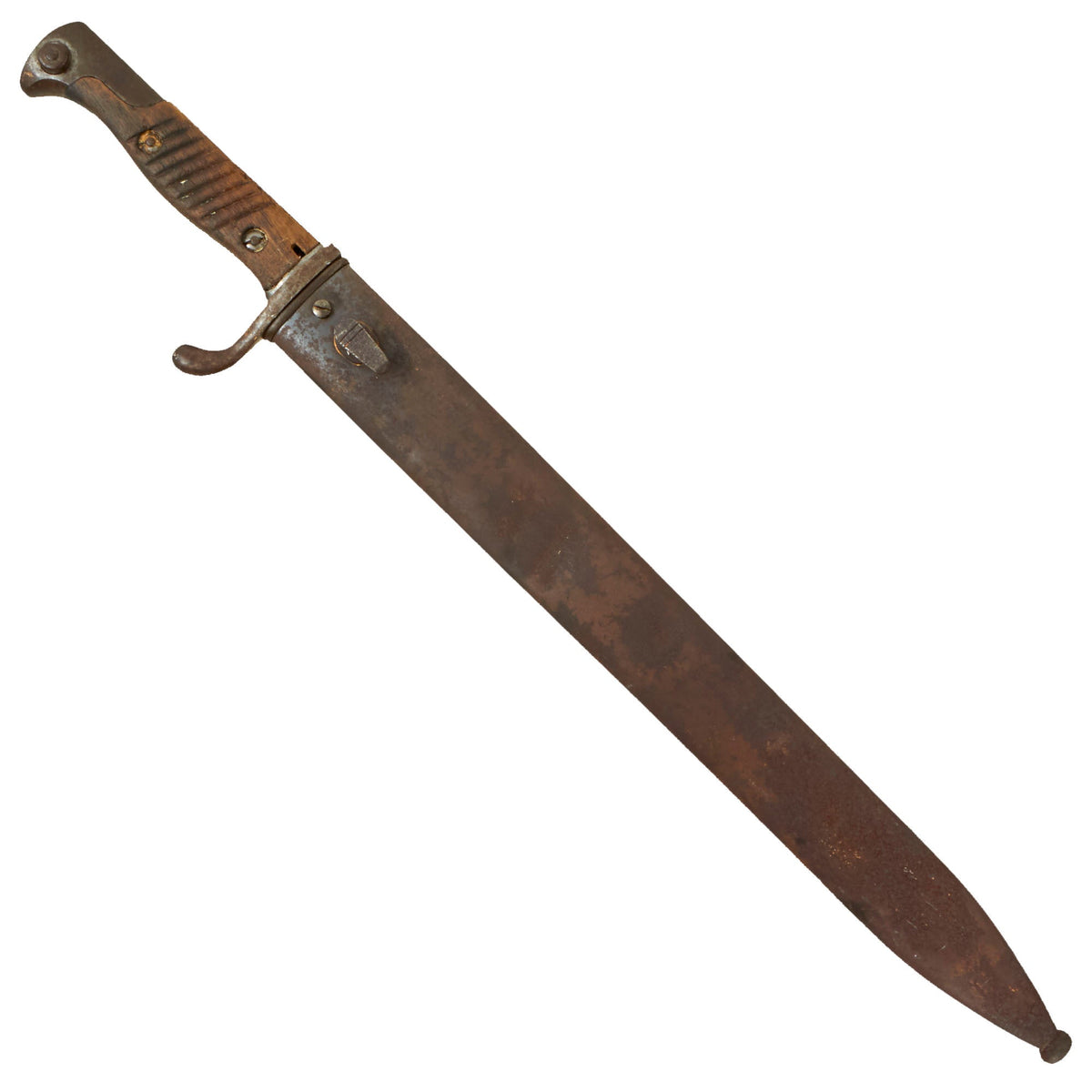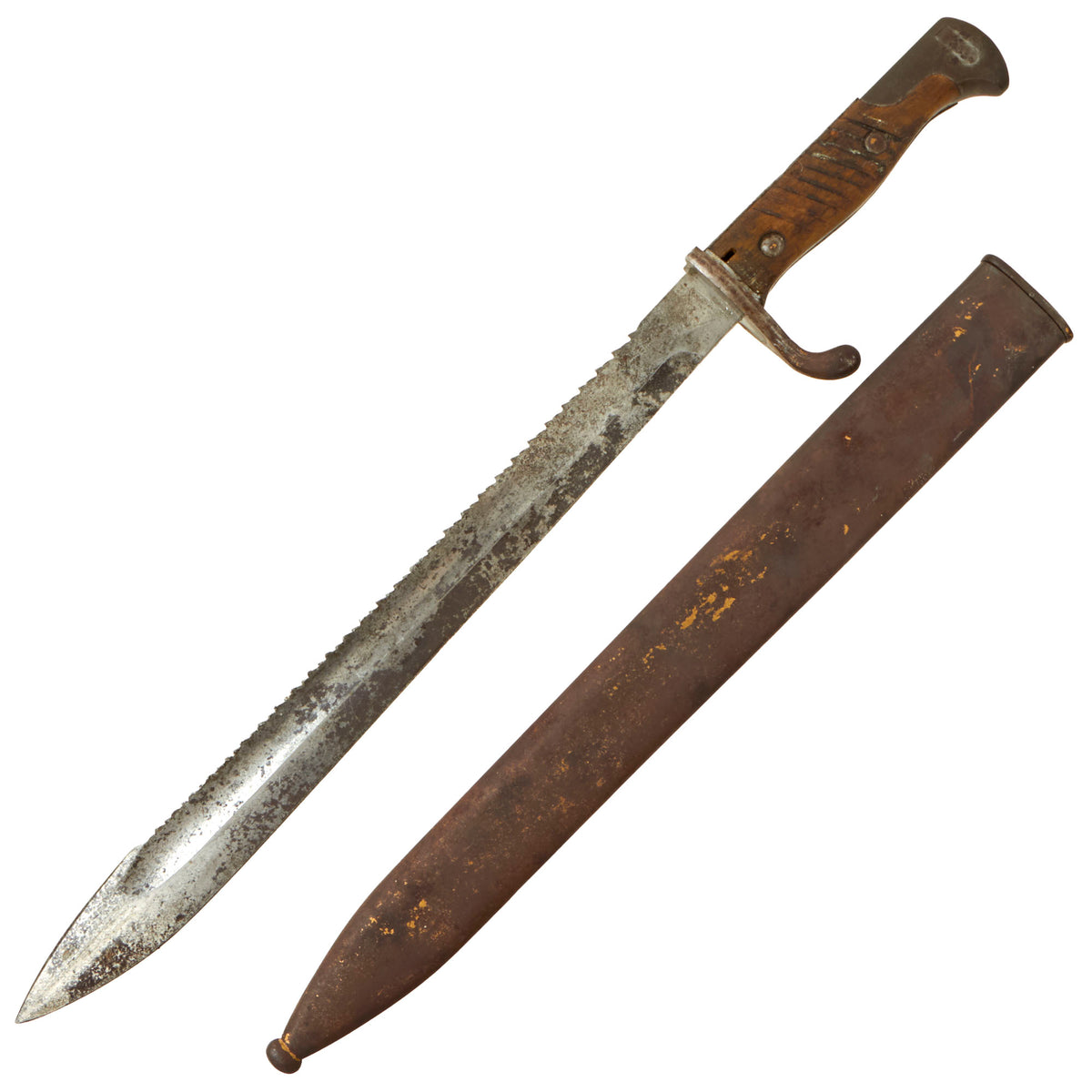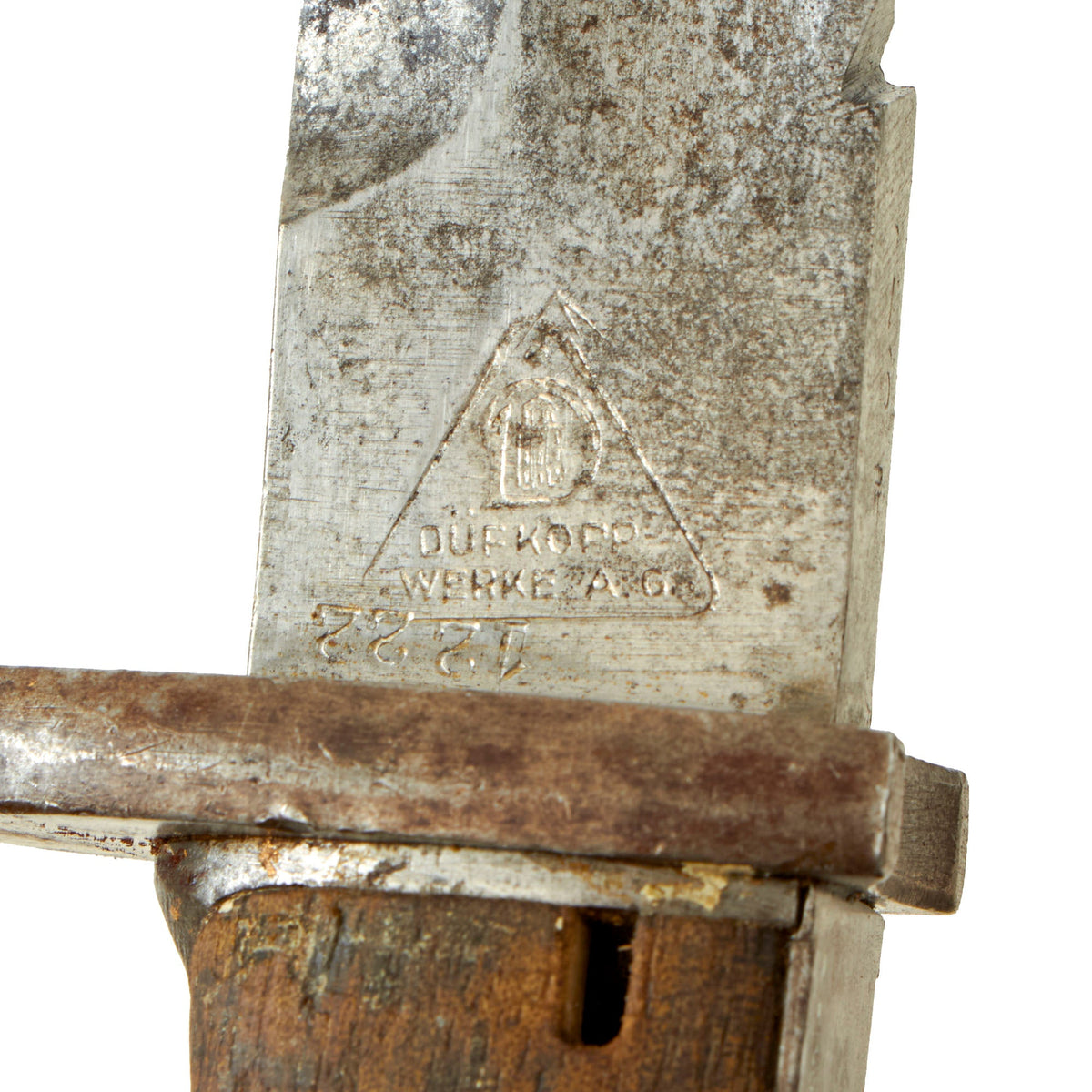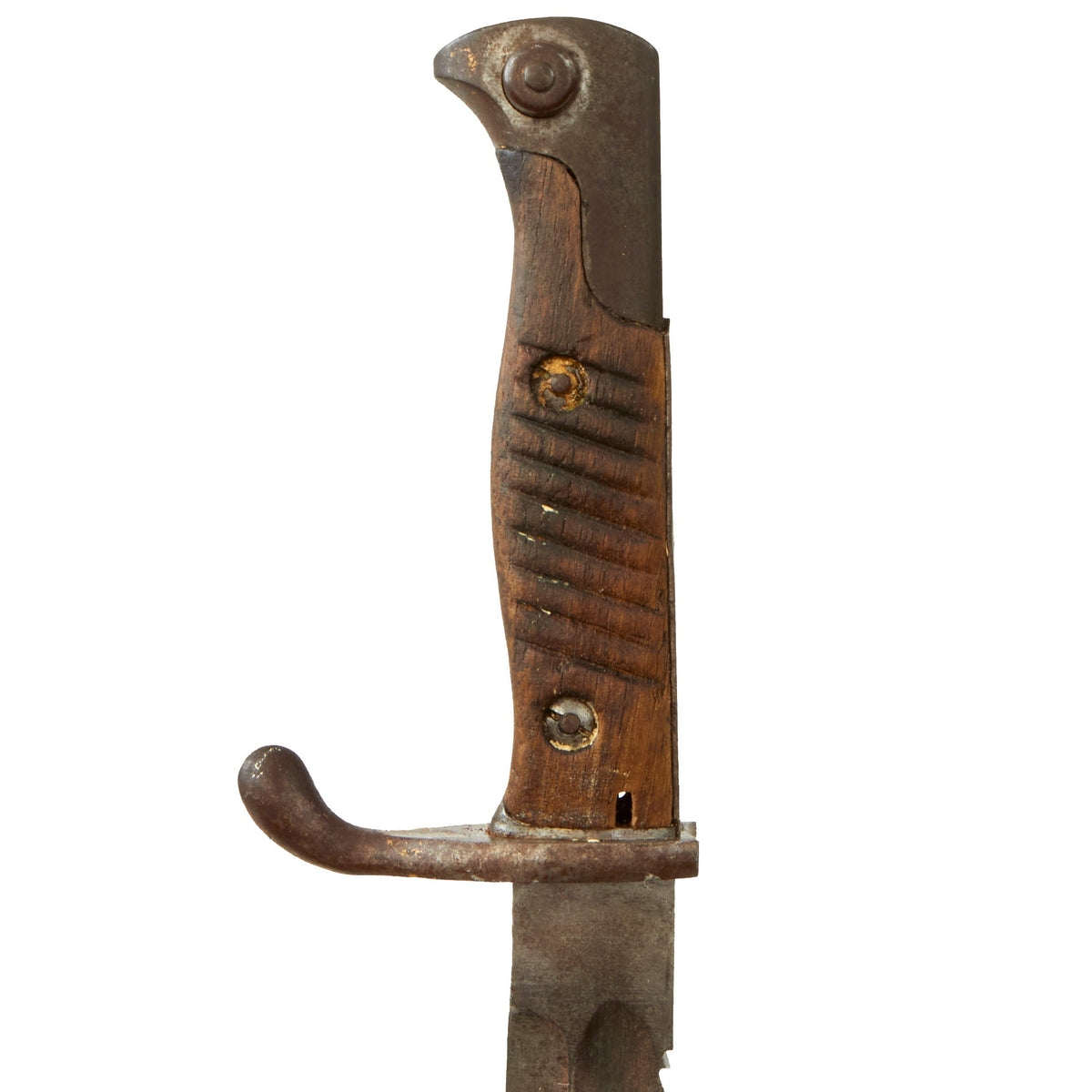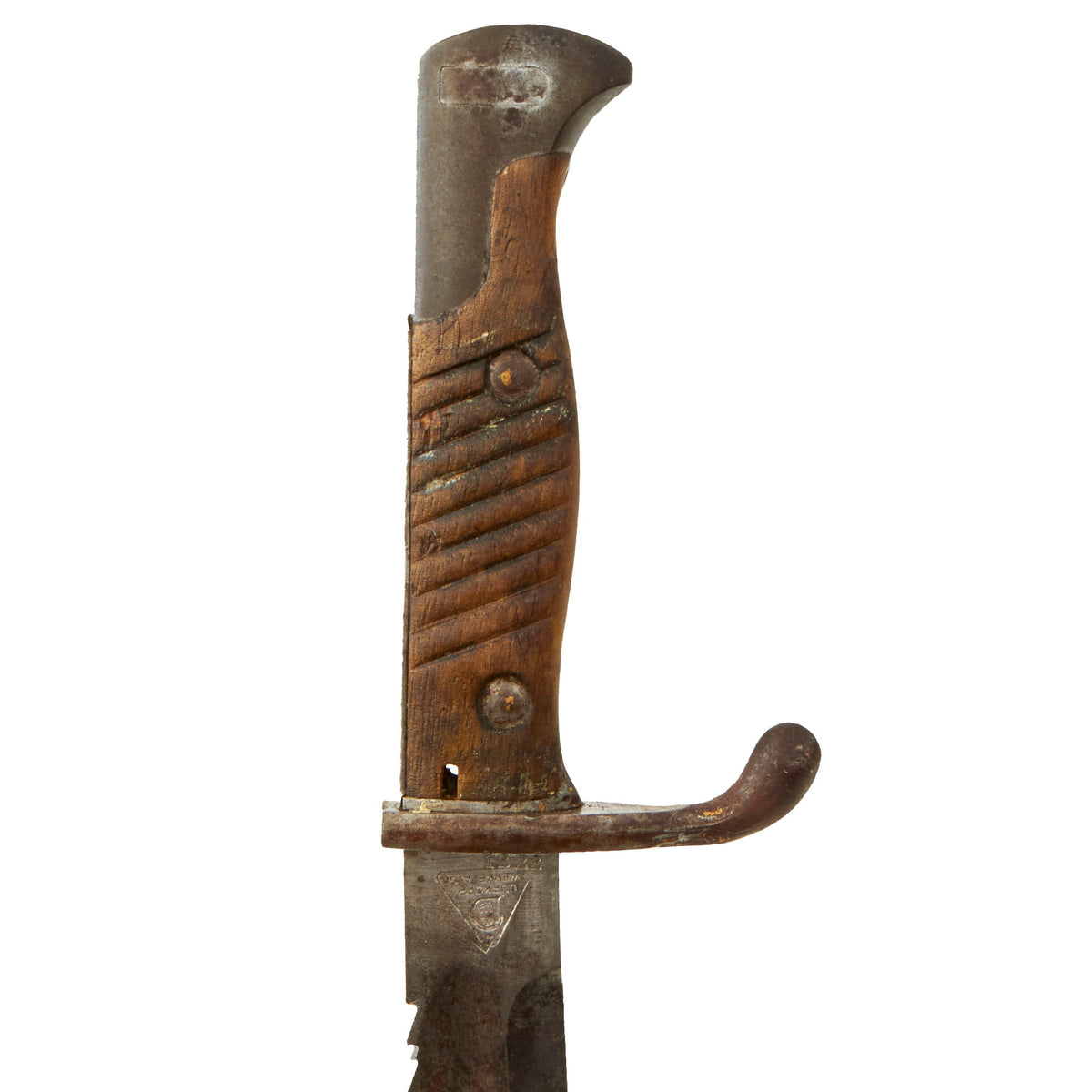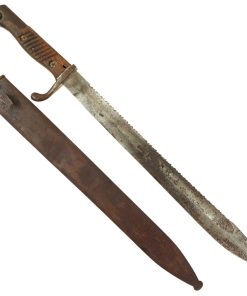Original German WWI M1898/05 n/A Butcher Sawback Bayonet by Dürkopp-Werke. A.-G. with Scabbard Original Items
$ 495,00 $ 148,50
Original Item: Only One Available. This is a great example of the M-1898/05 Bayonet (Seitengewehr), which was the most common German Bayonet of the First World War. It was intended for use on the standard issue service rifle of Imperial Germany: the Mauser-designed Gewehr 98 (GEW 98). It features a heavy 14.5-inch steel blade with distinct bulge toward the point, giving extra weight and power to the business end, known as a “butcher blade”. This version is known as n/A (neuer Art = newer model). This second pattern lacks the first pattern’s vestigial muzzle ring (or ‘ears’) and has a flashguard on the back of the grip.
This example has a very desirable “sawback” blade, which was intended for use by pioneers to saw through brush and obstacles. Unfortunately a rumor got out that it was intended to inflict grievous harm on enemies, so a lot of the sawback bayonets had this feature removed, making them hard to find. This example has a blade in good condition. There is some heavy staining and oxidation as shown, but the patina looks great overall.
This example has a nice set of original grooved wood grips that have a good color and some chipping & damage as shown, with a nice hilt with some rusting and past overpaint with a great patina. Bayonet lock is fully functional, and the flash guard is undented, which is rare as these were often used as a hammer in the field. There is pitting throughout and a scent of oils and cleaning products still present. The blade ricasso is maker marked (top line faint):
DÜRKOPP
WERKE A.-G.
The firm has a history of automobile, ball bearings and motorcycle production but both Kochs Adler and Dürkopp’s history began with sewing machines. Dürkoppwerke’s history began in 1867 when Heinrich Dürkopp, who had earlier completed building a sewing machine on his own co-founded Dürkopp and Schmidt with a colleague, Carl Schmidt. The firm later dropped Schmidt from its name. Operating out of the backroom of a clock-maker’s factory, the new firm made both household and industrial sewing machines. As the business profile became enhanced among local customers, the firm moved to a new building close to market street, Bielefeld in 1870. The company expanded sales to other regions in Germany and introduced specialized machines for shoe-making. In 1885, it began production of bicycles and ball bearings which were an early success. During its early period, Dürkopp experimented with many mechanical ideas and products, led by its founder, the firm began automobile production introducing a successful product, Knipperdolling to the market in 1906. The firm has produced three wheeled and two wheeled motorcycles.
After World War I, the firm’s debt profile grew and fell under the receivership of banks who went on to sell its automobile unit to Mercedes Benz. During the Second World War, the firm produced cylindrical bearings for tanks and weapons. Kochs Adler, which was majority-owned by the Oetker family, produced munitions and employed forced labor. Those products were jettisoned after the war and the firm went back to its core products, making sewing machines, conveyor belts, bicycles and motorcycles. By 1962, the firm concentrated on making sewing machines and conveyor belts for the garment industry. In 1990, it merged with Koch Adler, another Bielefeld based industrial sewing machine manufacturer that was founded in 1860.
The blade is very faintly dated 1916 on the blade’s spine and has a partial proof mark. The blade is in fair condition, with the original arsenal sharpening, which is still mostly intact, with some heavy wear. The original blued finish is completely faded, and there is a bunch of surface rust on the blade. We have left it intact to preserve the lovely patina.
The steel scabbard is fair, with some heavy denting and oxidation. The body of the scabbard does have pitting present. The frog button is still intact and unbent. There are bits of what appear to be gold paint on one side which could be removed.
An excellent example of what is becoming a difficult bayonet to find in such fine condition, never messed with, just the way we like to find them. Ready to display.
Dimensions:
Blade length: 14 1/2”
Blade Style: Single Edged “Butcher” with Fuller & Sawback
Overall length: 19 3/4”
Crossguard: 2 3/4”
Scabbard length: 15 1/4″
Fast Shipping with Professional Packaging
Thanks to our longstanding association with UPS FedEx DHL, and other major international carriers, we are able to provide a range of shipping options. Our warehouse staff is expertly trained and will wrap your products according to our exact and precise specifications. Prior to shipping, your goods will be thoroughly examined and securely secured. We ship to thousands clients each day across multiple countries. This shows how we're dedicated to be the largest retailer on the internet. Warehouses and distribution centres can be located throughout Europe as well as the USA.
Note: Orders with more than one item will be assigned a processing date depending on the item.
Before shipping before shipping, we'll conduct a thorough inspection of the items you have ordered. Today, the majority of orders will be delivered within 48 hours. The delivery time will be between 3-7 days.
Returns
The stock is dynamic and we cannot completely manage it because multiple stakeholders are involved, including our factory and warehouse. So the actual stock may alter at any time. It's possible that you may not receive your order once the order has been made.
Our policy is valid for a period of 30 days. If you don't receive the product within 30 days, we are not able to issue a refund or an exchange.
You can only return an item if it is unused and in the same state as the day you received it. You must have the item in its original packaging.
Related products
Uncategorized
Uncategorized
Uncategorized
Uncategorized
Uncategorized
Uncategorized
Uncategorized
Armoured Fighting Vehicles of the World: AFVs of World War One (Hardcover Book) New Made Items
Uncategorized
Uncategorized
Band of Brothers ORIGINAL GERMAN WWII Le. F.H. 18 10.5cm ARTILLERY PIECE Original Items
Uncategorized
Uncategorized
Uncategorized
Armored Burgonet Helmet & Polearm from Scottish Castle Leith Hall Circa 1700 Original Items
Uncategorized
Uncategorized
Uncategorized
Uncategorized
Uncategorized
Uncategorized
Uncategorized
Uncategorized

